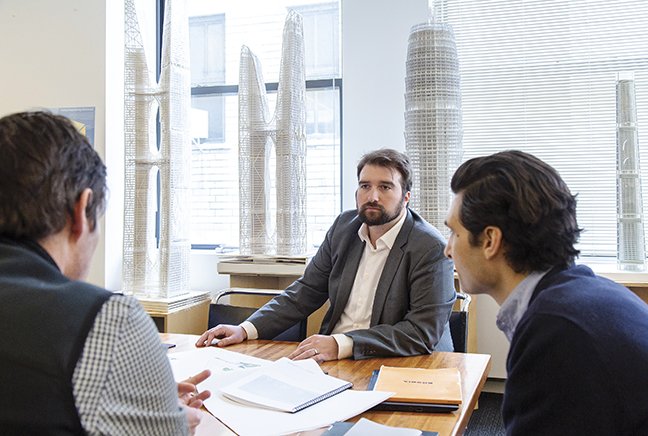Skyscraper enthusiast

Above: In designing skyscrapers, Johnson and his team are thinking “better, leaner, or more efficient.” The plexiglass models in the background were built in-house for recent projects. Credit: Danielle Campbell
Civil engineering alumnus seeks novel engineering solutions
July 9, 2019
Benton Johnson has taken engineering to new heights—including the world’s tallest building. Johnson (Civil Engineering ’05, M.S. ’07) works as a senior structural engineer at Skidmore, Owings & Merrill (SOM), a firm known for innovation and skyscrapers.
“This is a very interesting place to work because they’re always pushing the limits, pushing the boundaries, and finding new ways to work on things,” he said. “It’s unusual if you get multiple projects in a row with the same criteria. I remember one day I was bored in my job—just one day. There’s no limit of intellectual stimulation at this place.”
Johnson grew up in Bemidji, Minn., with “aspirations to do something in engineering and something big with my career.” As a graduate student, he worked on one of the first research projects in the University of Minnesota’s Multi-Axial Subassemblage Testing (MAST) Laboratory, where structures can be subjected to simulated earthquakes, hurricanes, and tornadoes. His thesis examined how to anchor concrete walls to foundations and their performance in seismic events.
This background immediately piqued interest when he interviewed at SOM’s Chicago headquarters. Concrete shear walls provide key structural elements for strengthening buildings to resist wind and seismic events.
The company’s portfolio included a number of tall skyscrapers including the Sears Tower (now Willis Tower) in Chicago and the One World Trade Center in New York (the tallest building in the United States), and Burj Khalifa in Dubai (the tallest building in the world at 828 meters).
In 2007, Johnson went to work for SOM, and his first project was the Burj Khalifa.
Johnson has remained at the company ever since and engaged in one cutting-edge project after another. For example, researching how to construct buildings with timber beams instead of steel or concrete. The company devised a structural solution of wood beams with reinforced concrete joints, which would reduce the construction carbon footprint by up to 75 percent compared to traditional steel and concrete.
Johnson expects that timber will become increasingly cost-effective and common in buildings up to 20 stories.
“Timber is one of the most sustainable materials we can use,” he said.
“Most future development will happen in cities,” Johnson said. “The most sustainable way to build cities is to use a lot of timber, which means multi-story construction.”
Johnson has experimented with 3D-printed technology as well.
In 2015, his team created a thermoplastic polymer building model for the U.S. Department of Energy’s Oak Ridge National Laboratory. Last year, they worked with the U.S. Army Corps of Engineers to 3D print a concrete barracks model.
Johnson has risen into management and constantly seeks engineering solutions that expand the realm of the possible.
“I try to think of not necessarily taller or first,” he said, “but better, leaner, or more efficient.
“Particularly with sustainability and climate change,” he added, “our motivation is not necessarily to be pushing the boundary just for the sake of doing it. It’s about achieving something that wasn’t otherwise possible within some kind of constraint.”
Story by Kermit Pattison
Read about more College of Science and Engineering alumni pushing the boundaries in their field:
Charlie Spanjers, Kyle Olson, Brad Guertin: Bike nerds
